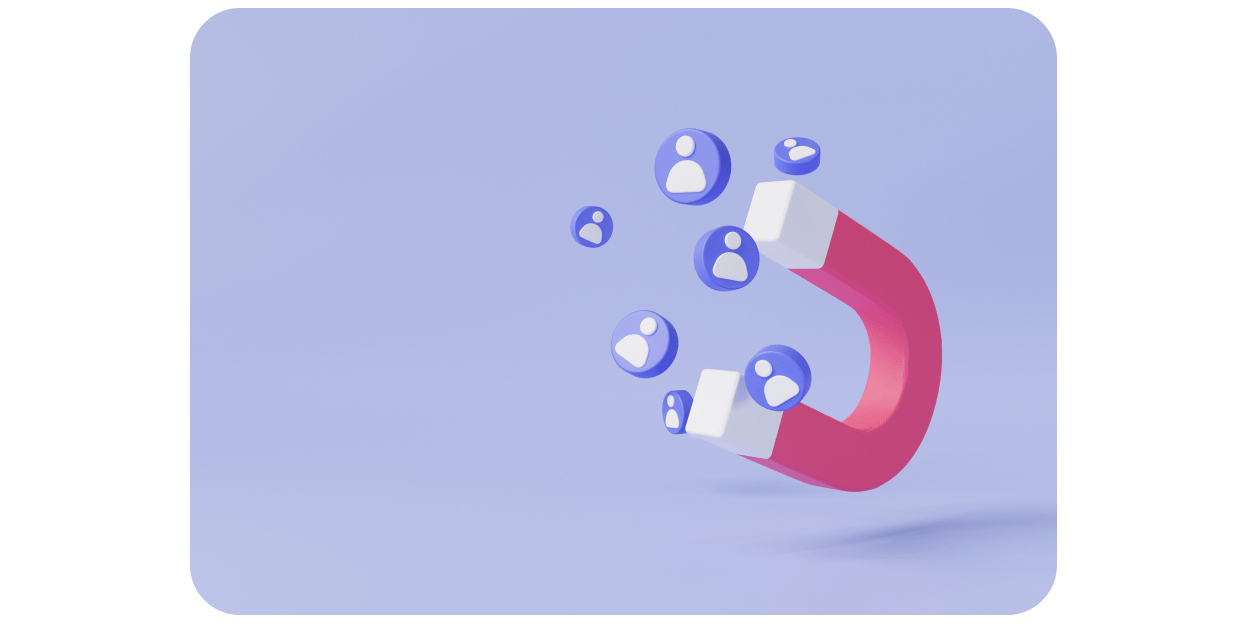Customer retention is essential for your business to succeed. Find out how to effectively build and measure customer loyalty with our in-depth guide.
Customer retention is the key to higher profits for your business. Existing customers bring in most of your revenue, who will also bring in the majority of your future revenue.
Acquiring a new customer is often more expensive than keeping an existing one, making it more cost-effective to focus on building customer loyalty and retention.
By focusing on your existing customers, you are investing in the long-term success of your business. This guide will explore how you can retain customers effectively, boost clientele, and keep them coming back for more.
What is customer retention?
Customer retention is a business's ability to hold on to a customer, even after completing a transaction or interaction. As a business, you want to retain every customer to keep them from choosing your competitors and allow your business to grow.
You must deliver an experience that is built on trust and helps customers to see and appreciate the value of your product or service. The next time they're looking to buy or renew, or you've got a new feature that you want to upsell, there shouldn't be any doubt in the customer's mind who they will choose.
Why is customer retention necessary?
1. Drive Revenue
Increasing retention by just 5% can boost revenue by 25-95%. Existing customers have already bought into your brand once before; they understand the products and services on offer and are much more open to spending money with you, especially if you provided a great experience the first time around.
2. Save Money
Returning customers tend to spend more and buy more often without your business needing to spend time and money on expensive marketing or sales campaigns. Loyal customers are more likely to start doing your selling for you.
On average, 72% of customers will share a positive experience with six or more people. Capitalise on this by regularly asking for feedback from your customers. The more happy customers you have, the more positive reviews you'll have coming into the business.
3. Build Customer Loyalty
65% of consumers head elsewhere due to poor customer service, while 66% say the quality and features of a product or service were the number-one reason for customer loyalty. Once you start taking customer retention seriously, you'll begin to notice why certain customers are leaving you and be able to take action to do something about it.
4. Gain Valuable Feedback
97% of consumers are more likely to stay loyal to a brand that takes their feedback on board. Collecting regular customer feedback can help you paint a picture of your overall customer experience and give your customers a chance to let their voices be heard. Every piece of feedback is an opportunity to listen, learn, and improve to help your business build stronger relationships, improve customer retention, and boost customer loyalty.
What is a customer retention strategy?
A customer retention strategy is a business strategy created to encourage increased customer loyalty, increased profitability, and decreased turnover.
It should be as detailed as possible and include:
- Analysis of current activity and its progress
- Areas for improvement
- Research into industry standards
- Competitors and market trends
- A complete, tangible, targeted plan
What is a positive customer retention strategy?
Positive customer retention strategies include actions that will increase customer loyalty while reducing customer turnover.
By rewarding customers for remaining in a relationship with you, your business can build customer relationships and maximise the revenue you get from each one.
Positive Customer Retention Strategies
1. Responding to reviews
Customer reviews can tell you so much about your business, from what people think about the quality of your products to how your customer service team deals with complaints.
Take the time to read, respond, and take on board what your customers are saying, both good and bad. Address all negative reviews efficiently and quickly by first offering an apology and then providing them with a solution. Your customer will feel like you value their opinion, will feel heard, and will more likely come back if they trust you to follow through with a plan.
To improve your customer retention, you need to know why people are leaving. Start asking for regular feedback across your entire customer journey. It could be that people love your products, but your delivery company is consistently letting you down with lateness or poor service. The earlier you spot these trends and take action, the easier it is to prevent customers from going elsewhere.
2. Starting a loyalty programme
A loyalty programme rewards customers' devotion to you and incentivises them to return to your brand.
Discounts, special offers, and freebies are great but usually a one-off. Many cafes and coffee shops provide a loyalty scheme based on devoted shopping habits. Consider offering customers a loyalty card to prevent them from being tempted to shop elsewhere. After nine transactions, providing them with a free drink keeps you and your customer happy and in a long-term relationship.
A referral scheme will also attract new customers while retaining existing ones. Your customers will be rewarded for marketing your business, and you will receive guaranteed sales from more people.
3. Enticing customers with offers and exclusivity
People want to be treated like they're special. An exclusive VIP club, membership to hidden product launches, and limited-time offers are fantastic ways to grab a customer's attention. These schemes play on people's 'fear of missing out' (FOMO), enticing them to join in to avoid missing opportunities.
Identify your highest-paying customers and find a way to retain them by offering them a unique product or service. Making them feel special and rewarding their loyalty will ensure they remain patrons of your business. It's also the highest spenders and exclusive members who will talk highly about your business to others.
4. Personalising their experience
Developing a personal relationship with your customers starts by offering them a personalised shopping experience. An impressive 57% of shoppers will willingly provide you with their personal data if they have access to personalised offers and discounts.
Encourage your clients to provide you with their date of birth, email address, and likes and dislikes. This will help you recognise areas of personalisation to make them feel valued and special. Always use their name when speaking to them, even on emails and SMS campaigns. Offer a birthday discount to celebrate their special day with exclusive deals on their favourite items.
5. Staying in touch
To ensure customer retention, you need to be memorable. You want your business to be at the forefront of your customer's minds when required, and this means you need to keep in touch, stay relevant, and be unforgettable.
Create a detailed communications calendar to help you regularly stay in touch with your client base. This can include phone calls, SMS campaigns, email newsletters, live events, and even hand-written notes. Organise them so you have a good balance of communications across pre-sales and post-sales journeys, with sufficient touch points along the buying process.
Remember to stay in touch without appearing too needy or spam-like, or you risk getting blocked.
6. Offering exceptional customer experience (CX)
A good customer experience starts with anticipating your customer's needs and wants and providing it to them before they ask. Identify any pain points and enhance their experience.
Happy and satisfied customers will spend more, come back to you more often, and will leave you glowing reviews for everyone else to see. Invest in training all your customer service staff so that they interact with customers professionally and patiently.
7. Publishing interesting and share-worthy content
Customers should be able to turn to you first for news, updates, and guidance, not just about your products but your industry as a whole. Therefore, you need to position your business as a figure of authority and knowledge.
Leverage various content techniques like videos, blog posts, how-to guides, podcasts, infographics, and case studies. Ensure that everything you publish is authentic, alluring, and educational.
Simplify technical jargon into bite-sized information so customers know you care about their experience.
8. Diversifying your offer
One of the best ways to keep your clients and customers returning to you for more is to offer them more options. Even if you offer one product, consider different features, upgrades, or even colour options that can encourage the customer to return for more.
For example, if your business sells rucksacks and nothing else, you can offer a range to cover men's, women's, children's, travel, back-to-school, work, and even smaller sizes. Market these in a way that entices the customer to shop more and complete the entire collection from only you.
What is a negative customer retention strategy?
Negative customer retention strategies are used to end customer relationships when it is no longer profitable for a business to retain specific customers or they are not the best fit for the business.
Customer Retention Strategies
1. Increasing the price of products or services: Customers often look for products or services that are the most affordable or cost-effective. Therefore, increasing prices will likely result in a customer purchasing a product or service elsewhere.
2. Lacking in attractive deals: Offering deals that are not attractive or affordable will help deter potential unsuitable customers or encourage existing customers to look elsewhere.
3. Reducing your services: Customers will often stay with a company even if they have put up their prices. A way to counteract this is to reduce the number of services you offer as part.
4. Closing the customer's account: Closing a customer's account may seem like a drastic move. Still, it might be appropriate in certain circumstances, particularly if the company has already warned the customer and then proceeds to close their account.
How to measure customer retention
By using the customer retention rate formula, you can determine the percentage of your customers who stayed with the business over a given period.
What is the retention rate formula?
To determine your customer retention rate, you need to decide the period you want to measure: monthly, quarterly or even annually if you're looking more long-term.
Once you know how long you're measuring, the customer retention rate formula you need to use is:

Let's look at an example to make things easier:
If you begin the quarter with 100 customers (number of customers at the start of the period), your sales team brings on board another 25 (number of customers acquired during the period), but you lose a further 15. This takes your number of customers at the end of the period to 110.
Your customer retention rate formula will look a little something like this:
(110 – 25) / 100 X 100 = 85% Retention
Now that you have your customer retention rate, you can start to track it over time.
What is customer churn?
Your customer churn rate, or customer attrition rate, is the percentage of customers that stopped using your product or service in a given time frame. You can calculate customer churn differently depending on what you want to measure. It may be the total number of customers lost, a percentage of customers lost versus your total number of clients, or you may choose to track the revenue value of the customers you've lost.
How to Measure Customer Churn Rate
The simplest method uses the following formula:

A reasonable customer churn rate is very industry-dependent, but for most B2B operators, nothing higher than 7-10% would be acceptable.
The frequency with which you measure customer churn and over what period depends on the customer base. Small businesses can calculate customer churn annually or semi-annually, but larger firms with more customers may need to do so monthly or quarterly.
How to Reduce Customer Churn
1. Segment your customer base
Customer segmentation will help you better understand which groups are more at risk of churning and why.
Every business is different in terms of its customer segments and groupings. Your business model should inform your segmentation; do you work with different-sized businesses, offer various services, or provide products at a range of prices?
You may want to group your customers by acquisition channel or product engagement. You can also look at recency, frequency and monetary value metrics, or churn risk.
2. Review your business value proposition vs. your competitors
Use a simple SWOT analysis to identify your strengths, weaknesses, opportunities, or threats. Once you have all the information noted for your business, replicate the process for your competitors. This is especially important if you believe you are losing customers to your competitors' products or services.
From here, you can map out strategies to reduce customer churn for critical segments. This analysis will also allow you to make a more compelling business case if you need to persuade your management and secure the budget you may need for the project.
3. Identify short-term and long-term improvement opportunities
Once you have a data-led understanding of what impacts your business churn rate, you should create a roadmap for reducing churn rates for your key segments.
Initiate cross-functional collaboration with your product development team to prioritise the changes that will impact churn most. Involve your customer service, insight, marketing, and sales teams so that priorities can be agreed upon across the business from representatives from all customer touchpoints.
4. Analyse your business processes
Sometimes, it can be the business processes that tick away behind the scenes that are causing customer churn problems.
Small or new businesses might find reviewing and iterating on their processes easier. In contrast, large or legacy businesses often find themselves dealing with cumbersome, ingrained processes that are rigid and difficult to optimise.
It's important to review:
- How the product is sold
- How the client is onboarded
- How relationships are managed
- How upselling or renewal takes place
5. Create a marketing plan to communicate better with customers
The final step is developing a solid marketing plan to improve customer communication.
It would be best if you aimed to engage them by acknowledging the issues they've flagged and the feedback they've provided. Being honest with your customers about your weaknesses and transparent about your improvement plans can help to re-engage customers and strengthen relationships.
Approach your messaging with appreciation, authenticity, and inclusivity, offering reassurance that ongoing feedback from your clients is encouraged for continuous improvement. Plan email campaigns, paid media campaigns, and PR pushes to spread the word about your improvements. You can also go back and respond to previous customer reviews or feedback with an update on how things have changed to encourage customers to give you a second chance.
Customer Retention Metrics
There are a couple of other popular customer retention metrics that you'll want to keep track of when measuring your customer loyalty.
1. Product Return Rate
You might be more concerned with your product return rate if you're a retail business. 30% of all products ordered online are returned – which is bad news for eCommerce businesses.
Calculating your product return rate is easy enough:

If you start asking your customers for feedback after they've returned an item, you'll begin to uncover common reasons why they're sending things back and spot trends and previously unseen issues. Once you know all this, you can do something about it, improve your products, and ultimately bring your return rates down.
2. Customer Lifetime Value (CLV)
Customer lifetime value lets a business determine the total revenue they can expect from a single customer during their entire time with the business. The more loyal your customers are, the greater their lifetime value.
The first thing you will want to do is figure out your customer value. To do this, use the following steps:

Next, you will need to work out your average customer lifespan. Use the following formula to help:

Now you're ready to calculate your customer lifetime value. Take your customer value and your average customer lifespan and multiply them together like so:

3. Net Promoter Score (NPS)
Net Promoter Score measures customers' loyalty by asking them one simple question: "How likely are you to recommend our company to friends, family or colleagues?".
NPS scores are measured on a scale from -100 to +100. The higher the number, the better the score and depending on how customers rate your business, they'll fall into one of three categories:
Promoters: Score the company a nine or a 10. They're loyal customers who are likely to act as brand ambassadors and come back time and again.
Passives: Respond with a seven or an eight. They're happy with the service but have yet to be blown away. If you're using NPS to help with customer retention, then your passive customers are where you want to focus your efforts.
Detractors: Give a score between 0 and 6. These are your unhappy customers and most at risk of churning.
4. Revenue Churn
Revenue churn is the overall percentage of revenue lost from not retaining existing customers over time. While customer churn allows a business to understand the number of customers leaving, revenue churn shows the financial detraction of their not returning.
It may occur from a cancelled subscription, halted repeat purchases, downgrades on plan levels (and therefore payments), or a complete end to the business-customer relationship.
Calculate revenue churn monthly as other finances would be.
- Take the monthly recurring revenue amount at the beginning of the month
- Subtract from it the monthly recurring revenue at the end
- Then, further subtract any revenue as a result of upselling or cross-selling from existing customers
- Divide the figure by the original monthly recurring revenue amount. This may be a positive or negative percentage, but it should not include revenue from new customers throughout the month.
- Some businesses also calculate revenue churn in line with the period of their customer churn figure to give a practical indication of the monetary impact.
5. Customer Revenue Growth Rate
Customer revenue growth rate is the rate of revenue growth from existing customers within a set period.
An increasing customer revenue growth rate indicates that the company is doing well and motivates customers to repeat purchases. This helps to increase spending and demonstrates loyalty behaviours.
The revenue generated from existing customers at the end of a period should be compared to either:
- The revenue generated from existing customers at the start of that period
- That revenue from a previous period
6. Purchase Ratio
A purchase patio demonstrates the percentage of a business's customer base that returns to make a repeat purchase. It typically applies to products and subscriptions, but businesses can use the purchase ratio to judge marketing efficiency and customer care for other services, too.
To calculate the purchase ratio, the number of customers who have returned to make another or further purchase should be compared to the total number of customers overall.
7. Repeat Customer Rate
The repeat customer rate refers to the ratio of customers who have given a business their repeat custom within a given period; it provides a percentage of customers who demonstrate loyalty to the brand, product, or service.
Take the total number of customers who made an additional or multiple purchases throughout a stipulated period. Divide this by your second figure: the total number of customers over the same period, including new customers recruited throughout this time. This will give you a percentage figure.
Do you need help with your customer retention?
At Feefo, we give you the tools to build better customer relationships. Whether it's asking for feedback or using the voice of your customers to listen, learn, and improve your customer experience, our tailor-made service can help you increase customer retention and build customer loyalty.
Request a call back from our friendly team today to find out how.



